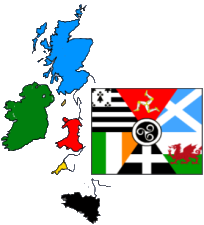Transceltic is dedicated to the Celtic Nations and the Pan Celtic Movement. We are often asked how the six Celtic nations are distinctly identified.

The recognised Celtic nations are:






These nations have a Celtic language that is still used and has been spoken into modern times. Parts of north west Spain, in particular Galicia and Asturias have sometimes been seen as Celtic due to their unique culture when compared to other areas of that region. However, unlike the six nations, no Celtic language has been spoken into the modern era.
There are two branches of the Celtic languages still spoken, Brythonic and Goidelic. Brythonic is spoken in Brittany, Cornwall and Wales. Goidelic is spoken in Scotland, Ireland and Isle of Man. All areas have seen a revitalisation and increased use of Celtic which has been widely promoted, such as Ynsee Gaelg by the Manx Heritage Foundation and Cornish Language Partner- ship - Keskowethyans an Taves Kernewek.
In recent years there has also been a growth in learning and speaking the Celtic language in the 'New World' with active associations in Australia, New Zealand, USA and Canada. The associations provides a means for those of Celtic heritage to preserve and celebrate their linguistic and cultural legacy. In addition there has been a revival of Scots Gaelic in Canada's Cape Breton, once home in the 1800's to 100,000 Gaelic speaking Scottish immigrants, with an estimated 2,000 Gaelic speakers in 2018.
The Pan Celtic Movement seeks to promote greater appreciation of the shared heritage of the Celtic Nations. Transceltic is part of a grand tradition of Pan Celtic organisations, which includes the International Celtic Congress and the Celtic League.
International Celtic Congress
The International Celtic Congress is a non-political cultural organisation that promotes the Celtic language in the six nations of Ireland, Scotland, Brittany, Ireland, Isle of Man and Cornwall. For more information on the Congress' annual meeting visit www.ccheilteach.ie.
Celtic League
A separate organisation with a more political outlook is the Celtic League. It promotes the benefits of pan-celtic cooperation between the six Celtic Nations. For more information on the Celtic league visit www.celticleague.net.
Other articles of interest